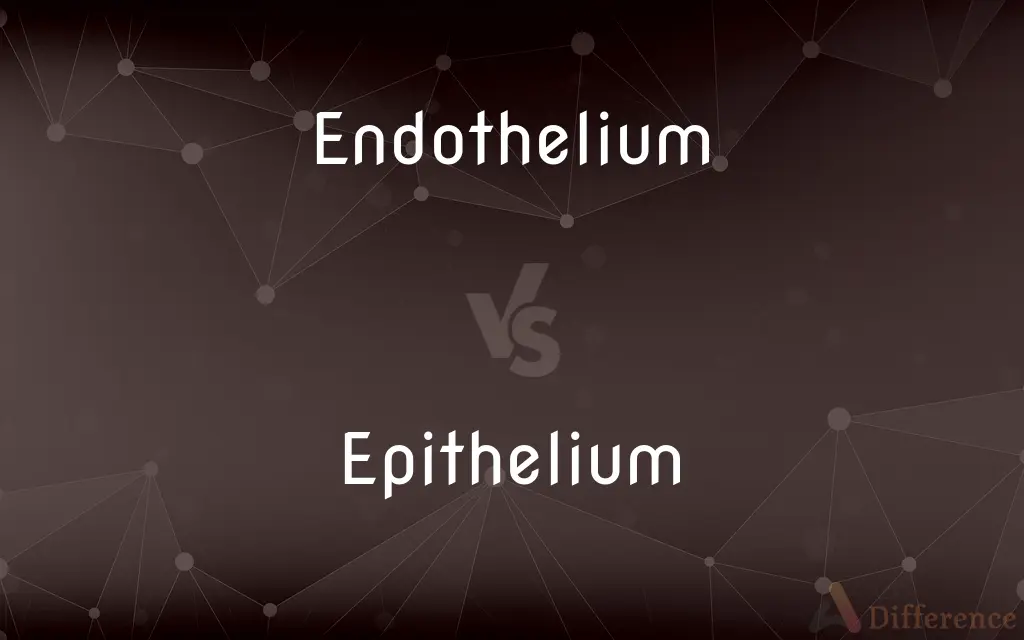Endothelium vs. Epithelium — What's the Difference?
By Tayyaba Rehman — Updated on November 1, 2023
Endothelium is the tissue lining blood vessels; epithelium covers body surfaces and cavities.

Difference Between Endothelium and Epithelium
Table of Contents
ADVERTISEMENT
Key Differences
Endothelium is a specialized type of epithelium that lines the interior of blood vessels, lymphatic vessels, and the heart. It plays a crucial role in vascular biology, including the control of blood pressure and blood clotting. In contrast, epithelium includes various types of tissues that line organs, glands, cavities, and skin.
While endothelium is a singular layer of cells, epithelium can vary in shape and layers, being simple or stratified. The endothelium serves primarily in the exchange of substances between the bloodstream and surrounding tissues. Epithelium protects surfaces, absorbs nutrients, and secretes substances.
Endothelium is involved in the creation of new blood vessels, a process known as angiogenesis. The epithelium, however, is not limited to such a role and is involved in many forms of secretion, sensation, and absorption throughout the body.
Diseases of the endothelium can lead to cardiovascular issues, as it is instrumental in maintaining vascular homeostasis. Epithelial dysfunction or damage is broader, affecting organs like the skin, lungs, and digestive tract, and can lead to a variety of diseases, including cancers.
Endothelial cells are typically flat and form a smooth lining, optimizing blood flow. Epithelial cells, on the other hand, can be flat, columnar, or cuboidal, adapting to the specific functions of the organ or tissue they cover, such as secretion, absorption, or protection.
ADVERTISEMENT
Comparison Chart
Location
Lines blood and lymphatic vessels, heart
Covers body surfaces, lines cavities and organs
Function
Regulates vascular activities
Provides protection, secretion, absorption
Cell Shape
Predominantly flat (squamous) cells
Varies (squamous, cuboidal, columnar)
Number of Cell Layers
Typically single layer (simple)
Can be single (simple) or multiple (stratified)
Associated Pathologies
Cardiovascular diseases
Cancers, skin diseases, organ-specific diseases
Compare with Definitions
Endothelium
Regulates the passage of materials
Damage to the endothelium impairs blood circulation.
Epithelium
Tissue covering body surfaces and linings
The epithelium protects the body's internal environment.
Endothelium
Involved in angiogenesis
Tumor growth often involves the stimulation of endothelium.
Epithelium
Forms glands and hair follicles
Glandular epithelium produces various secretions.
Endothelium
A single layer of squamous cells
Endothelium cells are smooth to facilitate blood flow.
Epithelium
Exhibits regenerative capabilities
The epithelium can regenerate quickly after injury.
Endothelium
Plays a role in blood pressure control
Hypertension can be an endothelium dysfunction.
Epithelium
Can be simple or stratified
Skin's outer layer is a stratified epithelium.
Endothelium
Tissue lining the interior surface of blood vessels
The endothelium is essential for vascular health.
Epithelium
Involved in secretion and absorption
Intestinal epithelium absorbs nutrients from food.
Endothelium
Endothelium is a single layer of squamous endothelial cells that line the interior surface of blood vessels, and lymphatic vessels. The endothelium forms an interface between circulating blood or lymph in the lumen and the rest of the vessel wall.
Epithelium
Epithelium () is one of the four basic types of animal tissue, along with connective tissue, muscle tissue and nervous tissue. It is a thin, continuous, protective layer of cells.
Endothelium
A thin layer of flat epithelial cells that lines serous cavities, lymph vessels, and blood vessels.
Epithelium
Membranous tissue composed of one or more layers of cells separated by very little intercellular substance and forming the covering of most internal and external surfaces of the body and its organs.
Endothelium
(anatomy) A thin layer of flat epithelial cells that lines the heart, serous cavities, lymph vessels, and blood vessels.
Epithelium
(anatomy) A membranous tissue composed of one or more layers of cells which forms the covering of most internal and external surfaces of the body and its organs: internally including the lining of vessels and other small cavities, and externally being the skin.
Endothelium
The thin epithelium lining the blood vessels, lymphatics, and serous cavities. See Epithelium.
Epithelium
The superficial layer of cells lining the alimentary canal and all its appendages, all glands and their ducts, blood vessels and lymphatics, serous cavities, etc. It often includes the epidermis (i. e., keratin-producing epithelial cells), and it is sometimes restricted to the alimentary canal, the glands and their appendages, - the term endothelium being applied to the lining membrane of the blood vessels, lymphatics, and serous cavities.
Endothelium
An epithelium of mesoblastic origin; a thin layer of flattened cells that lines the inside of some body cavities
Epithelium
Membranous tissue covering internal organs and other internal surfaces of the body
Common Curiosities
What types of cells are in epithelium?
Epithelial cells can be squamous, cuboidal, or columnar, depending on their location and function.
Are endothelial cells found in organs?
Endothelial cells line the blood vessels within organs, but they are not the primary tissue of organs.
What is the primary function of the endothelium?
The endothelium regulates blood vessel functions, including blood clotting and pressure control.
Can endothelium regenerate?
Yes, endothelial cells can regenerate, which is crucial for vessel repair.
What is endothelial nitric oxide?
It's a molecule produced by endothelial cells that helps regulate blood vessel dilation.
Do all blood vessels have endothelium?
Yes, all blood vessels have an inner lining of endothelial cells.
What does stratified epithelium mean?
It's an epithelium composed of multiple layers of cells.
Is epithelium part of the skin?
Yes, the outer layers of the skin are composed of epithelial tissue.
Does epithelium contain nerve cells?
Epithelium itself doesn't contain nerves but can have nerve endings associated with it.
Is endothelium involved in inflammation?
Yes, endothelial cells can contribute to inflammation by regulating immune cell movement.
How does endothelium affect heart health?
Endothelial dysfunction can lead to atherosclerosis and heart disease.
What is the role of epithelium in the lungs?
The lung epithelium is involved in gas exchange and protecting the respiratory tract.
Can epithelial tissue serve as a barrier?
Yes, one of its main functions is to act as a protective barrier.
Can epithelium be cancerous?
Yes, cancers that originate in epithelial tissue are known as carcinomas.
Share Your Discovery

Previous Comparison
Duplicate vs. Replication
Next Comparison
Curd vs. CordAuthor Spotlight
Written by
Tayyaba RehmanTayyaba Rehman is a distinguished writer, currently serving as a primary contributor to askdifference.com. As a researcher in semantics and etymology, Tayyaba's passion for the complexity of languages and their distinctions has found a perfect home on the platform. Tayyaba delves into the intricacies of language, distinguishing between commonly confused words and phrases, thereby providing clarity for readers worldwide.
















































